梳状排序主要是对冒泡排序的改进。气泡排序总是比较相邻的值。所以 倒置 一个接一个地被移除。梳状排序通过使用大于1的间隙改进了气泡排序。间隙从一个较大的值开始,并在每次迭代中缩小1.3倍,直到达到值1。因此,梳状排序会删除多个 反转计数 只需一次交换,性能优于气泡排序。 根据经验,收缩系数为1.3(通过在超过200000个随机列表上测试Combsort)[来源: 维基 ] 虽然平均而言,它比气泡排序更有效,但最坏的情况仍然是O(n) 2. ). 下面是实现。
C++
// C++ implementation of Comb Sort #include<bits/stdc++.h> using namespace std; // To find gap between elements int getNextGap( int gap) { // Shrink gap by Shrink factor gap = (gap*10)/13; if (gap < 1) return 1; return gap; } // Function to sort a[0..n-1] using Comb Sort void combSort( int a[], int n) { // Initialize gap int gap = n; // Initialize swapped as true to make sure that // loop runs bool swapped = true ; // Keep running while gap is more than 1 and last // iteration caused a swap while (gap != 1 || swapped == true ) { // Find next gap gap = getNextGap(gap); // Initialize swapped as false so that we can // check if swap happened or not swapped = false ; // Compare all elements with current gap for ( int i=0; i<n-gap; i++) { if (a[i] > a[i+gap]) { swap(a[i], a[i+gap]); swapped = true ; } } } } // Driver program int main() { int a[] = {8, 4, 1, 56, 3, -44, 23, -6, 28, 0}; int n = sizeof (a)/ sizeof (a[0]); combSort(a, n); printf ( "Sorted array: " ); for ( int i=0; i<n; i++) printf ( "%d " , a[i]); return 0; } |
JAVA
// Java program for implementation of Comb Sort class CombSort { // To find gap between elements int getNextGap( int gap) { // Shrink gap by Shrink factor gap = (gap* 10 )/ 13 ; if (gap < 1 ) return 1 ; return gap; } // Function to sort arr[] using Comb Sort void sort( int arr[]) { int n = arr.length; // initialize gap int gap = n; // Initialize swapped as true to make sure that // loop runs boolean swapped = true ; // Keep running while gap is more than 1 and last // iteration caused a swap while (gap != 1 || swapped == true ) { // Find next gap gap = getNextGap(gap); // Initialize swapped as false so that we can // check if swap happened or not swapped = false ; // Compare all elements with current gap for ( int i= 0 ; i<n-gap; i++) { if (arr[i] > arr[i+gap]) { // Swap arr[i] and arr[i+gap] int temp = arr[i]; arr[i] = arr[i+gap]; arr[i+gap] = temp; // Set swapped swapped = true ; } } } } // Driver method public static void main(String args[]) { CombSort ob = new CombSort(); int arr[] = { 8 , 4 , 1 , 56 , 3 , - 44 , 23 , - 6 , 28 , 0 }; ob.sort(arr); System.out.println( "sorted array" ); for ( int i= 0 ; i<arr.length; ++i) System.out.print(arr[i] + " " ); } } /* This code is contributed by Rajat Mishra */ |
Python3
# Python program for implementation of CombSort # To find next gap from current def getNextGap(gap): # Shrink gap by Shrink factor gap = (gap * 10 ) / / 13 if gap < 1 : return 1 return gap # Function to sort arr[] using Comb Sort def combSort(arr): n = len (arr) # Initialize gap gap = n # Initialize swapped as true to make sure that # loop runs swapped = True # Keep running while gap is more than 1 and last # iteration caused a swap while gap ! = 1 or swapped = = 1 : # Find next gap gap = getNextGap(gap) # Initialize swapped as false so that we can # check if swap happened or not swapped = False # Compare all elements with current gap for i in range ( 0 , n - gap): if arr[i] > arr[i + gap]: arr[i], arr[i + gap] = arr[i + gap], arr[i] swapped = True # Driver code to test above arr = [ 8 , 4 , 1 , 3 , - 44 , 23 , - 6 , 28 , 0 ] combSort(arr) print ( "Sorted array:" ) for i in range ( len (arr)): print (arr[i],end = " " ) # This code is contributed by Mohit Kumra |
C#
// C# program for implementation of Comb Sort using System; class GFG { // To find gap between elements static int getNextGap( int gap) { // Shrink gap by Shrink factor gap = (gap*10)/13; if (gap < 1) return 1; return gap; } // Function to sort arr[] using Comb Sort static void sort( int []arr) { int n = arr.Length; // initialize gap int gap = n; // Initialize swapped as true to // make sure that loop runs bool swapped = true ; // Keep running while gap is more than // 1 and last iteration caused a swap while (gap != 1 || swapped == true ) { // Find next gap gap = getNextGap(gap); // Initialize swapped as false so that we can // check if swap happened or not swapped = false ; // Compare all elements with current gap for ( int i=0; i<n-gap; i++) { if (arr[i] > arr[i+gap]) { // Swap arr[i] and arr[i+gap] int temp = arr[i]; arr[i] = arr[i+gap]; arr[i+gap] = temp; // Set swapped swapped = true ; } } } } // Driver method public static void Main() { int []arr = {8, 4, 1, 56, 3, -44, 23, -6, 28, 0}; sort(arr); Console.WriteLine( "sorted array" ); for ( int i=0; i<arr.Length; ++i) Console.Write(arr[i] + " " ); } } // This code is contributed by Sam007 |
Javascript
<script> // Javascript program for implementation of Comb Sort // To find gap between elements function getNextGap(gap) { // Shrink gap by Shrink factor gap = parseInt((gap*10)/13, 10); if (gap < 1) return 1; return gap; } // Function to sort arr[] using Comb Sort function sort(arr) { let n = arr.length; // initialize gap let gap = n; // Initialize swapped as true to // make sure that loop runs let swapped = true ; // Keep running while gap is more than // 1 and last iteration caused a swap while (gap != 1 || swapped == true ) { // Find next gap gap = getNextGap(gap); // Initialize swapped as false so that we can // check if swap happened or not swapped = false ; // Compare all elements with current gap for (let i=0; i<n-gap; i++) { if (arr[i] > arr[i+gap]) { // Swap arr[i] and arr[i+gap] let temp = arr[i]; arr[i] = arr[i+gap]; arr[i+gap] = temp; // Set swapped swapped = true ; } } } } let arr = [8, 4, 1, 56, 3, -44, 23, -6, 28, 0]; sort(arr); document.write( "sorted array" + "</br>" ); for (let i=0; i<arr.length; ++i) document.write(arr[i] + " " ); // This code is contributed by decode2207 </script> |
输出:
Sorted array: -44 -6 0 1 3 4 8 23 28 56
插图: 让数组元素
8, 4, 1, 56, 3, -44, 23, -6, 28, 0
初始间隙值=10 收缩后间隙值=>10/1.3= 7. ;
8 4 1 56 3 -44 23 -6 28 0-6 4 1 56 3 -44 23 8 28 0-6 4 0 56 3 -44 23 8 28 1
新差距值=>7/1.3= 5. ;
-44 4 0 56 3 -6 23 8 28 1-44 4 0 28 3 -6 23 8 56 1-44 4 0 28 1 -6 23 8 56 3
新差距值=>5/1.3= 3. ;
-44 1 0 28 4 -6 23 8 56 3-44 1 -6 28 4 0 23 8 56 3-44 1 -6 23 4 0 28 8 56 3-44 1 -6 23 4 0 3 8 56 28
新差距值=>3/1.3= 2. ;
-44 1 -6 0 4 23 3 8 56 28-44 1 -6 0 3 23 4 8 56 28-44 1 -6 0 3 8 4 23 56 28
新差距值=>2/1.3= 1. ;
-44 -6 1 0 3 8 4 23 56 28-44 -6 0 1 3 8 4 23 56 28-44 -6 0 1 3 4 8 23 56 28-44 -6 0 1 3 4 8 23 28 56 no more swaps required (Array sorted)
时间复杂性: 该算法的平均事例时间复杂度为Ω(N 2. /2 P ),其中p是增量的数量。该算法的最坏情况复杂度为O(n) 2. )最佳情况复杂度为O(nlogn)。 辅助空间: O(1)。
梳子排序测验
本文由 拉胡尔·阿格拉瓦尔 .如果你喜欢GeekSforgek,并想贡献自己的力量,你也可以写一篇文章,然后将文章邮寄给评论-team@geeksforgeeks.org.看到你的文章出现在Geeksforgeks主页上,并帮助其他极客。
快照:
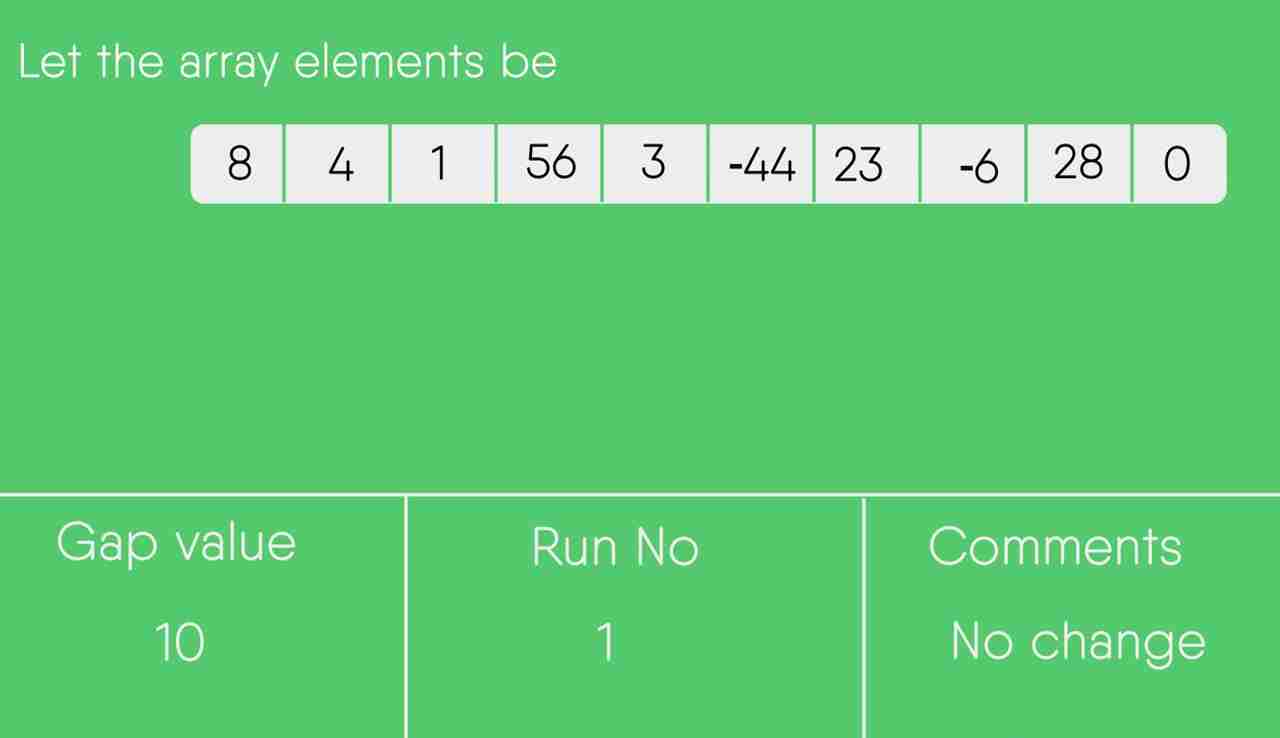

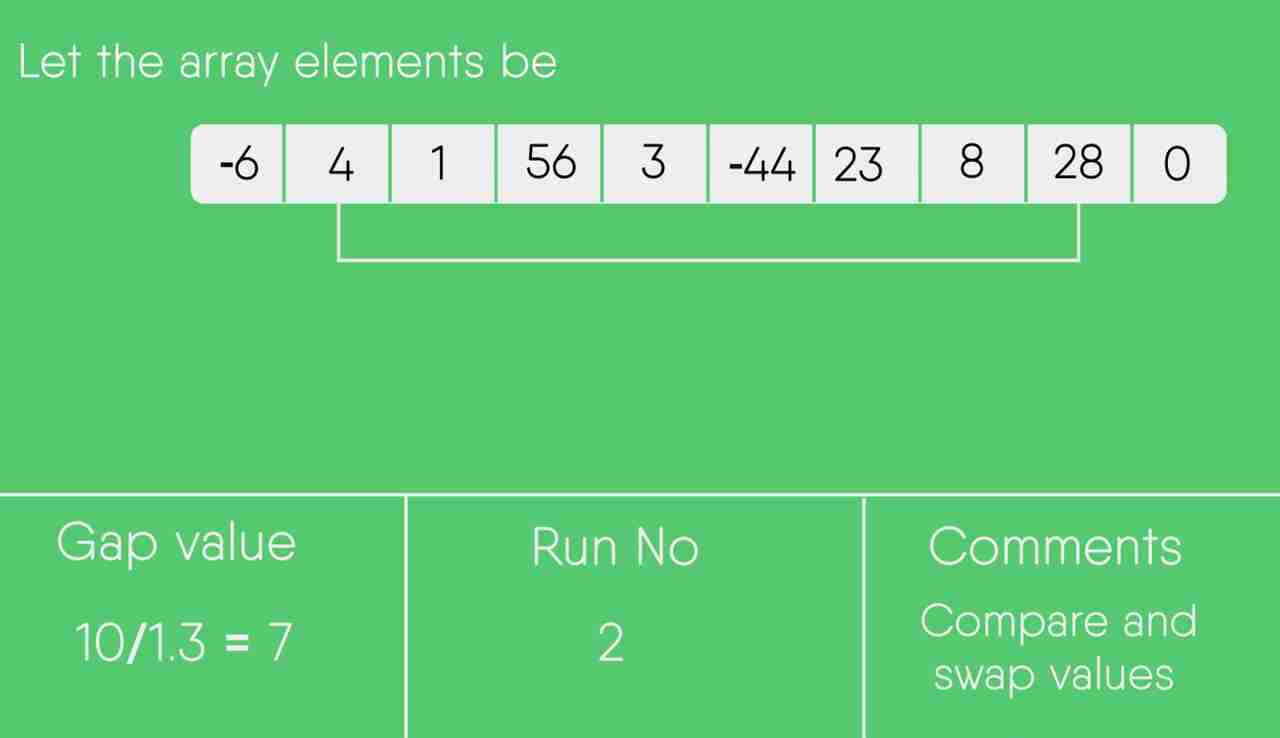
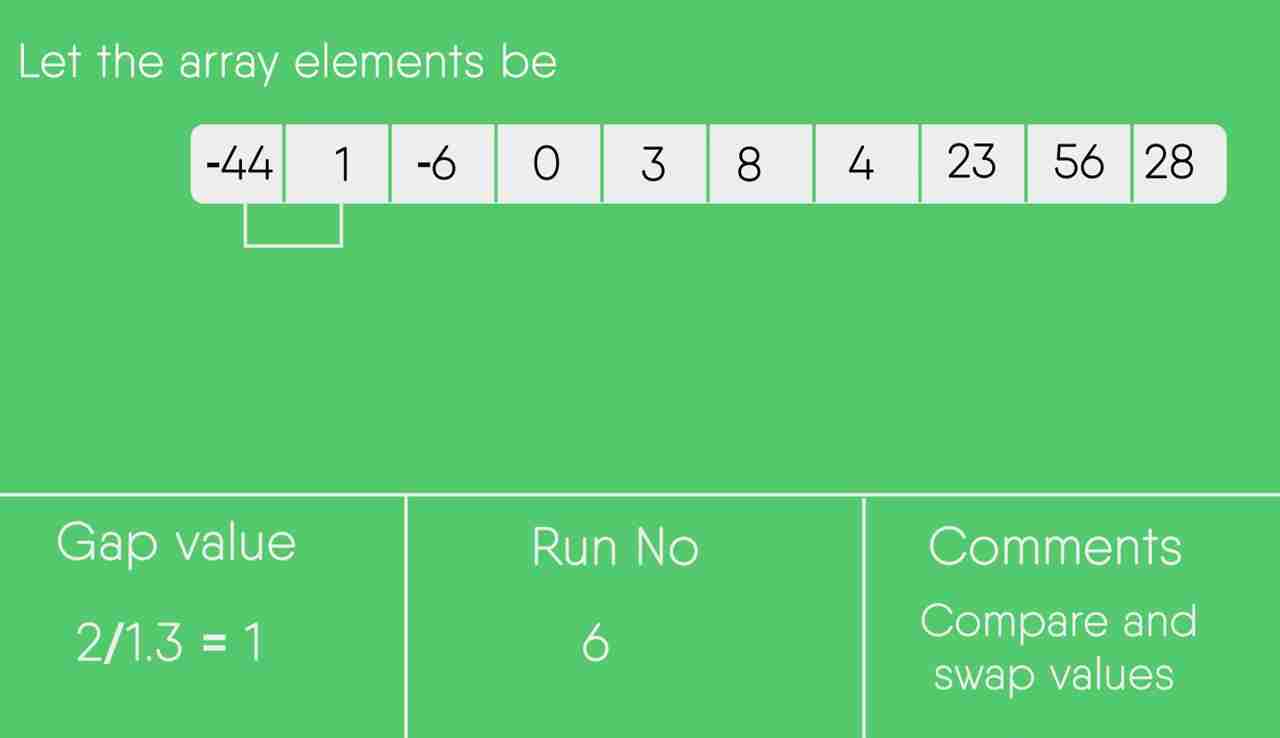
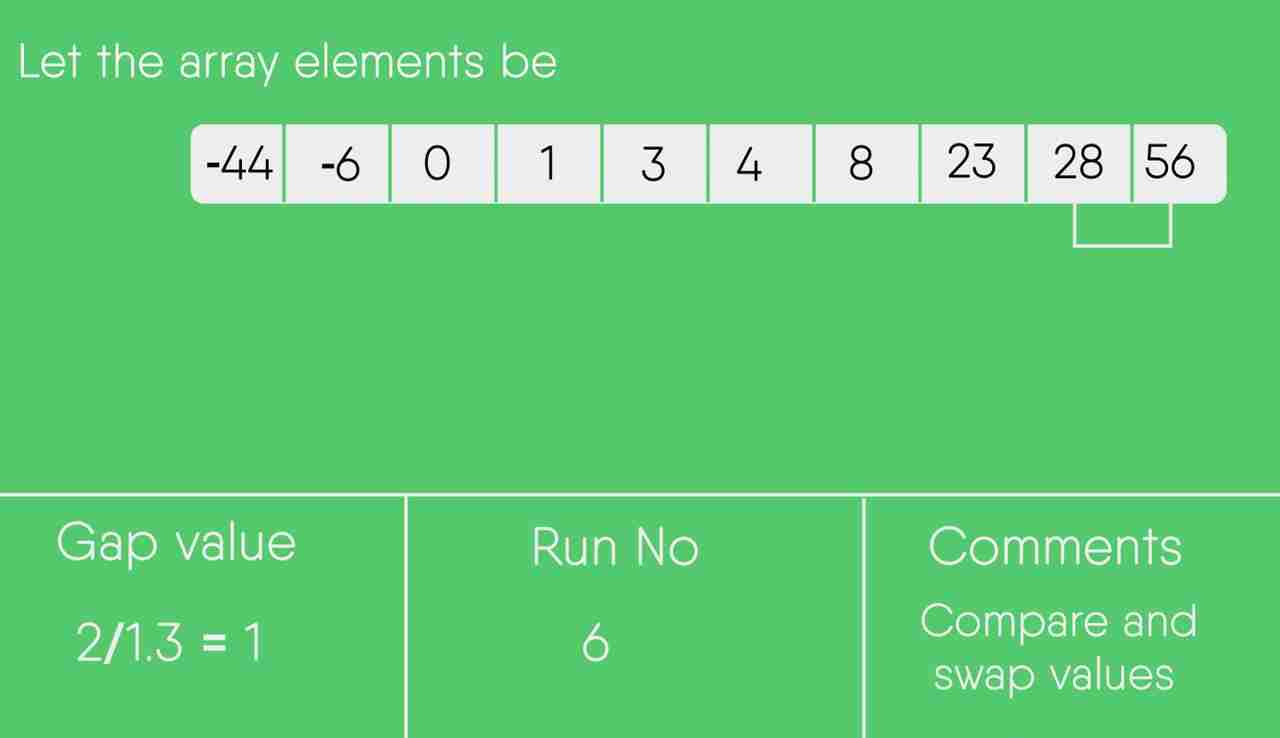
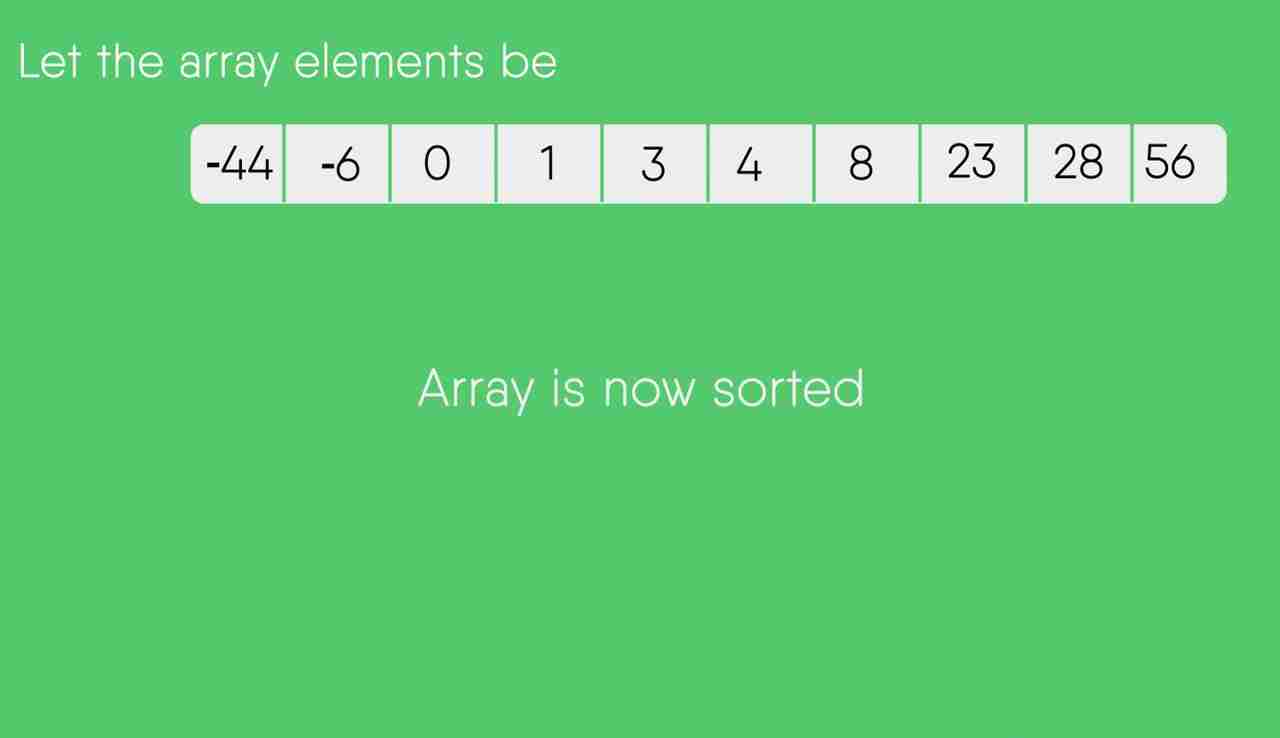
GeekSforgeks/GeekSquick上的其他排序算法 选择排序 , 气泡排序 , 插入排序 , 合并排序 , 堆排序 , 快速排序 , 基数排序 , 计数排序 , 斗式分拣 , 贝壳类 , 鸽子洞排序 如果您发现任何不正确的地方,或者您想分享有关上述主题的更多信息,请写下评论。


![关于”PostgreSQL错误:关系[表]不存在“问题的原因和解决方案-yiteyi-C++库](https://www.yiteyi.com/wp-content/themes/zibll/img/thumbnail.svg)



